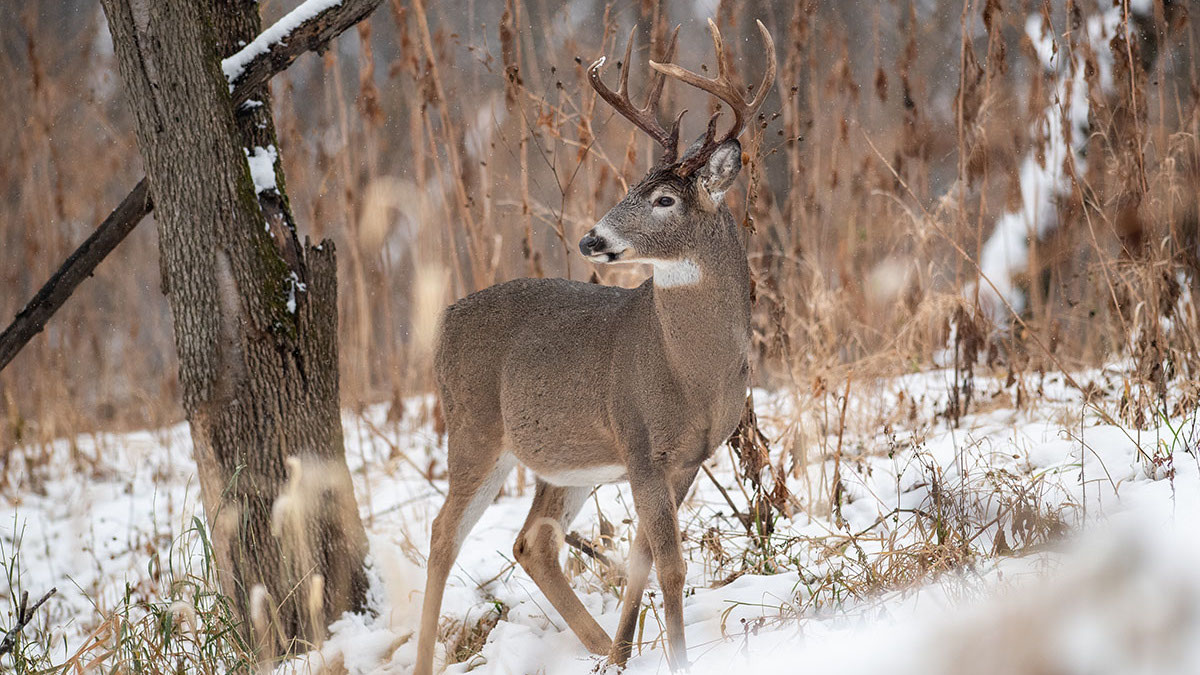
The whitetail rut gives the best odds for putting your tag on a big woods buck. Once the rut ends, movement is at an all-time low, with deer trying to recover and hide from any human intrusion. I used to think that this time of year was nearly impossible to be consistent with killing mature bucks, other than the occasional luck from another hunter bumping a deer into you. I realized that I was looking at this season wholly wrong and needed to look at it from a different perspective to find success.
Hunting Pressure
Growing up in Pennsylvania, the gun season opens after Thanksgiving, and we always joke that you must throw everything you know about deer hunting out the window to beat the orange army. We were half-joking, but once you start looking at the big woods through a scared deer’s eyes, you begin to put some pieces of the puzzle together.
I started reading many articles from Penn State’s Deer-Forest Blog about their findings with GPS-collared studies on deer in the big woods of Pennsylvania. Primarily, the results during gun seasons were fascinating. Most of the deer in the study would hole up in a small area during daylight hours with minimal movement, either reducing the usage of their core area or moving to a completely different location.
In my post-rut trail camera studies, I’ve found a few places where bucks will migrate to during the gun season madness. These typically include steep and thick areas. It’s helpful to identify the zones of pressure on a map ahead of time by marking the parking areas, ends of roads, and other potential locations for hunters to enter.
Still-Hunting
Still-hunting involves moving slowly through the woods, hoping to catch a deer feeding, traveling, or bedding before they see you. You can cover a lot of ground in a day and potentially create an opportunity for yourself rather than waiting for it to come to you. Plan your route at the beginning of the day, where you can keep the wind in your face.
The hardest part about still-hunting is knowing when to go fast and when to go at a snail’s pace. When I’m walking through areas of open woods or feeding areas, I tend to walk at a moderate pace and then slow way down when I get to the crest of a hill, walking through a bedding area, or any other kind of thicket that you think they might be hiding in. When you are in these high-potential areas and think you’re going slow, go slower. Take a few steps, glass, wait, and repeat.
Tracking
Tracking big woods bucks is a pastime in the country's northeast region and other areas where snow is prevalent. When there’s snow on the ground, finding a buck track to follow can be one of the most effective ways to get an opportunity.
Hal Blood of Maine is a well-known and respected guide who utilizes tracking as his primary tactic to shoot big woods bucks. Regarding tracking, you usually move much faster than still-hunting until you find a track you want to follow. Once you find a track, you must determine how old it is and what the deer was doing at the time to choose your speed in pursuing it. Hal says that if you move too slowly at the wrong times, you will run out of daylight before you get very far. Tracking takes a higher level of woodsmanship than most hunting styles, with reading the tracks for freshness and size and knowing when to slow down and speed up.
Wind Bumping
Wind bumping is a strategy similar to an old-fashioned deer drive but with a more tactical approach. You only need two people to implement wind bumping. The idea is to have one person slowly walk towards a bedding area, such as a point of a ridge, thick logging cut, or mountain laurel patch with the wind blowing to their back, with another person sitting on the most likely exit path for the deer.
Unlike deer drives, wind bumping is done slowly and methodically, usually with the deer coming out cautiously rather than in a full-blown sprint. For example, in December 2020, while hunting with my father, Joe Martonik, and good friend, Johnny Stewart, we wind-bumped the steep slope coming off a point of the ridge due to the amount of hunting pressure on the tops. My dad worked his way around the hill, and wind bumped an 8.5-year-old buck into me at 20 yards. The buck was looking behind him, using the terrain and cover as he tried to sneak out the back door, but it resulted in my biggest whitetail to date.
Hunting pressure can make hunting the big woods after the rut seems daunting, but sometimes changing your tactics and getting out of the treestand can pay dividends.
Image via Matt Hansen.





Conversation